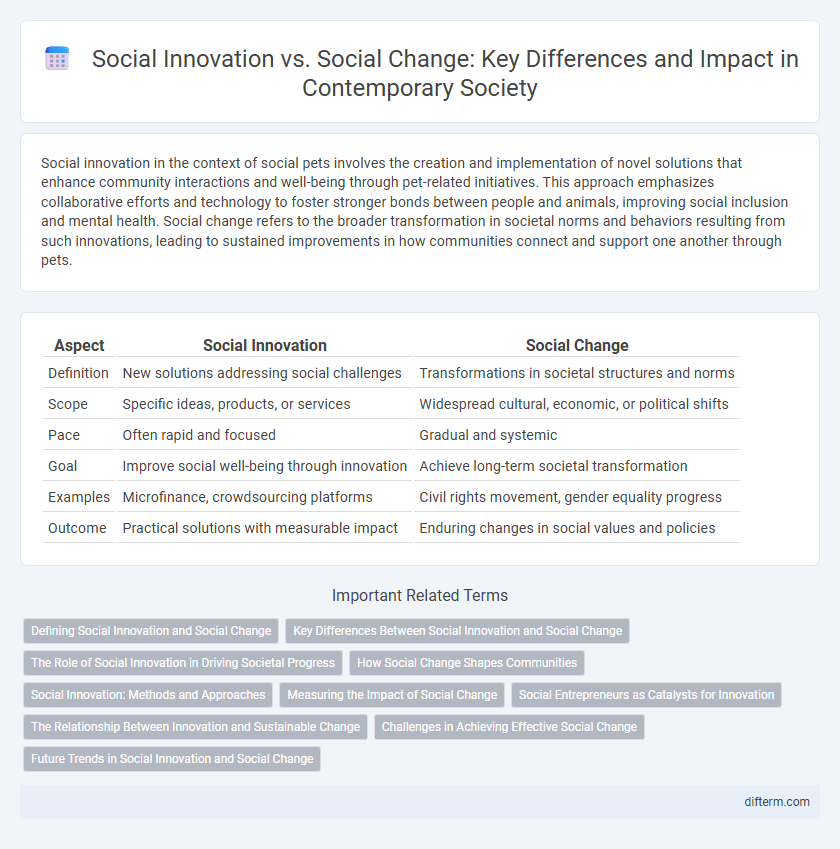Social innovation in the context of social pets involves the creation and implementation of novel solutions that enhance community interactions and well-being through pet-related initiatives. This approach emphasizes collaborative efforts and technology to foster stronger bonds between people and animals, improving social inclusion and mental health. Social change refers to the broader transformation in societal norms and behaviors resulting from such innovations, leading to sustained improvements in how communities connect and support one another through pets.
Table of Comparison
| Aspect | Social Innovation | Social Change |
|---|---|---|
| Definition | New solutions addressing social challenges | Transformations in societal structures and norms |
| Scope | Specific ideas, products, or services | Widespread cultural, economic, or political shifts |
| Pace | Often rapid and focused | Gradual and systemic |
| Goal | Improve social well-being through innovation | Achieve long-term societal transformation |
| Examples | Microfinance, crowdsourcing platforms | Civil rights movement, gender equality progress |
| Outcome | Practical solutions with measurable impact | Enduring changes in social values and policies |
Defining Social Innovation and Social Change
Social innovation refers to the development and implementation of new ideas, strategies, and concepts that address social needs more effectively than existing solutions. Social change involves the broader, long-term transformation of social structures, cultural norms, and collective behaviors within a society. While social innovation serves as a catalyst for social change, the latter encompasses the systemic shifts that result from sustained innovative actions and interventions.
Key Differences Between Social Innovation and Social Change
Social innovation involves the development and implementation of new strategies, concepts, or ideas that address social needs more effectively than existing solutions. Social change refers to the broader transformation of society's structures, values, or behaviors over time, often resulting from cumulative social innovations or external influences. The key difference lies in social innovation serving as a catalyst or method, while social change represents the outcome or larger societal shift.
The Role of Social Innovation in Driving Societal Progress
Social innovation introduces novel solutions that address complex societal challenges more effectively than traditional methods, accelerating social change by fostering inclusivity, sustainability, and resilience. By leveraging collaborative networks and emerging technologies, social innovation drives systemic transformation across sectors such as education, healthcare, and environmental sustainability. This dynamic process not only reshapes social norms but also enhances community empowerment and long-term societal progress.
How Social Change Shapes Communities
Social change transforms communities by altering cultural norms, values, and social structures, leading to new patterns of behavior and improved social conditions. Social innovation introduces novel solutions that address systemic problems, accelerating the pace and impact of social change. Together, social innovation and social change create resilient communities capable of adapting to evolving challenges and fostering inclusive growth.
Social Innovation: Methods and Approaches
Social innovation employs methods such as design thinking, participatory action research, and collaborative ecosystems to develop novel solutions addressing complex social challenges. These approaches prioritize user-centered design, community engagement, and cross-sector partnerships to create scalable and sustainable impact. By leveraging technology, behavioral insights, and co-creation processes, social innovation fosters adaptive and inclusive systems that drive measurable positive outcomes.
Measuring the Impact of Social Change
Measuring the impact of social change involves evaluating long-term improvements in community well-being, equity, and sustainability across socioeconomic indicators. Social innovation drives this process by introducing novel solutions that target root causes, enabling quantitative and qualitative assessments through data on behavior shifts, policy adoption, and resource allocation. Effective measurement frameworks integrate metrics such as social return on investment (SROI), community engagement levels, and systemic transformation outcomes to capture the depth and breadth of social change impact.
Social Entrepreneurs as Catalysts for Innovation
Social entrepreneurs drive social innovation by developing novel solutions that address systemic issues more effectively than traditional social change methods. Their focus on scalable impact and sustainable business models distinguishes social innovation from broader social change, which often relies on policy shifts or grassroots movements. By leveraging creativity, technology, and market principles, social entrepreneurs catalyze transformative improvements in education, healthcare, and environmental sustainability.
The Relationship Between Innovation and Sustainable Change
Social innovation drives the development of novel solutions addressing complex societal challenges, fostering systemic improvements that lead to sustainable social change. By integrating new ideas, technologies, and collaborative approaches, it reshapes social practices and institutional frameworks to ensure long-term impact. The relationship between innovation and sustainable change is characterized by continuous adaptation and scalability, which embed lasting value within communities and societies.
Challenges in Achieving Effective Social Change
Social innovation often faces challenges such as limited funding, resistance to established norms, and the complexity of addressing deep-rooted societal issues, which can hinder the scalability and sustainability of new solutions. Effective social change requires overcoming systemic barriers, engaging diverse stakeholders, and ensuring inclusive participation to create lasting impact. Navigating these challenges demands adaptive strategies that align innovative approaches with community needs and policy frameworks.
Future Trends in Social Innovation and Social Change
Emerging future trends in social innovation emphasize the integration of advanced technologies such as artificial intelligence and blockchain to create scalable solutions addressing social inequality and environmental sustainability. Social change increasingly relies on data-driven approaches and cross-sector collaboration, enabling more efficient resource allocation and inclusive community engagement. The convergence of digital platforms with grassroots activism is anticipated to accelerate transformative impacts on policy reform and social justice worldwide.
social innovation vs social change Infographic

 difterm.com
difterm.com